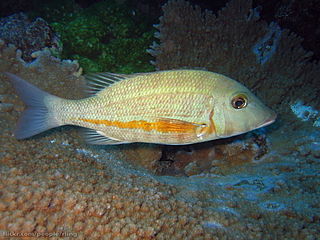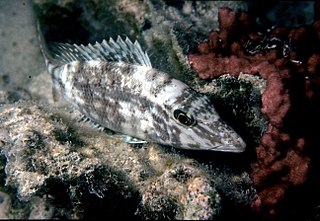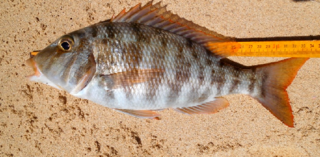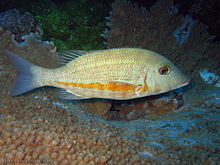
Lethrinidae are a family of ray-finned fishes belonging to the order Spariformes commonly known as emperors, emperor breams, and pigface breams.

Lethrinus miniatus, the trumpet emperor, redthroat emperor, sweetlip emperor, Sweetlip Swoose, island snapper, yellowmouth perch, yellowmouth snapper, lipper or nannygal, is a species of marine ray-finned fish belonging to the family Lethrinidae, the emperors and emperor breams. This species is found the eastern Indo-West Pacific region.

Monotaxis grandoculis, the humpnose big-eye bream, bigeye barenose, bigeye bream, bigeye emperor, grand-eyed porgy fish, humpnose sea-bream, large-eye bream,mu and roundtooth large-eye bream, is a species of marine ray-finned fish belonging to the family Lethrinidae, the emperors and emperor breams. This species is found in the Indian and Pacific Ocean.

Lethrinus olivaceus, common name longface emperor or long-nosed emperor, is a species of marine ray-finned fish belonging to the family Lethrinidae, the emperors or emperor breams. This species has a wide Indo-Pacific distribution.

Lethrinus obsoletus, the orange-striped emperor, yellow-banded emperor or yellowstripe emperor, is a species of marine ray-finned fish belonging to the family Lethrinidae, the emperors or emperor breams. This species has a wide Indo-Pacific distribution.

Lethrinus atkinsoni, the Pacific yellowtail emperor,, Atkinson's emperor, reticulated emperor, tricky snapper, Tuamotu emperor, yellow morwong or yellow-tailed emperor is a species of marine ray-finned fish benomging to the family Lethrinidae, the emperor breams and emperors. This fish is found in the Western Pacific Ocean.

Lethrinus erythracanthus, the orange-spotted emperor, orangefin emperor, and yellow-spotted emperor, is a species of marine ray-finned fish belonging to the family Lethrinidae. This species is found in the Indo-Pacific region.

Lethrinus harak, the thumbprint emperorblackblotch emperor or blackspot emperor, is a species of marine ray-finned fish belonging to the Family Lethrinidae. the emperors and emperor breams. This species is found in the Indo-Pacific region.

Lethrinus mahsena, common names the sky emperor, mahsena emperor, and cutthroat emperor, is a species of emperor fish. It grows to 65 cm (26 in) in length, but is commonly found at between 35 and 45 cm. This fish may be yellow to greenish-blue or olive-grey, becoming paler toward the belly. It is a non-migratory, reef-associated fish that has a high commercial value.

Lethrinus microdon, the smalltooth emperor, longface emperor or pigface bream, is a species of marine ray-finned fish belonging to the family Lethrinidae, the emperors and emperor breams. This species has a widespread distribution in the Indo-Pacific.

Lethrinus nebulosus, the spangled emperor, green snapper, morwong, north-west snapper, sand bream, sand snapper, sixteen-pounder, sharie, sheri and yellow sweetlip, is a species of marine ray-finned fish belonging to the family Lethrinidae, the emperors and emperor breams. This species is found the Indo-West Pacific region.
Lethrinus scoparius is a species of marine ray-finned fish belonging to the family Lethrinidae, the emperors and emperor breams. This species is found in the southwestern Indian Ocean. L. scoparius was previously considered to be a junior synonyms of L. nebulosus.
Lethrinus longirostrus is a species of marine ray-finned fish belonging to the family Lethrinidae, the emperors and emperor breams. This species is found in the Indo-Pacific region.

Lethrinus atlanticus, the Atlantic emperor, is a species of marine ray-finned fish belonging to the family Lethrinidae, the emperors and emperor breams. This species is found in the eastern Atlantic Ocean off the coast of western Africa.

Rhabdosargus is a genus of ray-finned fish belonging to the family Sparidae, which includes the seabreams and porgies. These fishes are found in the southeastern Atlantic Ocean and throughout the Indo-West Pacific, although mainly in the western Indian Ocean.

Crenidens is a small genus of three species of seabream from the family Sparidae from the western Indian Ocean. It was previously regarded as monotypic, with the sole species being the Karenteen sea bream Crenidens crenidens but two other species are now accepted as valid species, separate from the type species, C. crenidens.

Argyrops is a genus of marine ray-finned fishes belonging to the family Sparidae, the seabreams and porgies. These fishes are found in the coasts of Indian Ocean and near Australia.

Lethrinus variegatus, the slender emperor or variegated emperor, is a species of marine ray-finned fish belonging to the family Lethrinidae, the emperors and emperor breams. This fish has a wide Indo-Pacific distribution.

Lethrinus amboinensis, the Ambon emperor, is a species of marine ray-finned fish belonging to the family Lethrinidae, the emperors and emperor breams. This species is found in the Western Pacific Ocean.

Lethrinus borbonicus, the snubnose emperor, is a species of marine ray-finned fish belonging to the family Lethrinidae, the emperor breams and emperors. This species is found in the Western Indian Ocean and is of some importance to commercial fisheries in that region.




















